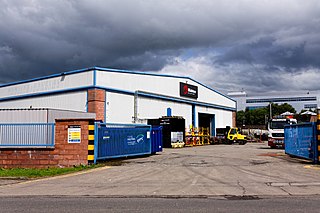Related Research Articles

William Dean was an English railway engineer. He was the second son of Henry Dean, who was the manager of the Hawes Soap Factory in New Cross, London. William was educated at the Haberdashers' Company School. He became the Chief Locomotive Engineer for the Great Western Railway from 1877, when he succeeded Joseph Armstrong. He retired from the post in 1902 and was replaced by George Jackson Churchward. He designed famous steam locomotive classes such as the Duke Class, the Bulldog Class and the long-lived 2301 Class.

Sir Daniel Gooch, 1st Baronet was an English railway locomotive and transatlantic cable engineer. He was the first Superintendent of Locomotive Engines on the Great Western Railway from 1837 to 1864 and its chairman from 1865 until his death in 1889.

Andrew Barclay Sons & Co., currently operating as Brodie Engineering, is a builder of steam and later fireless and diesel locomotives. The company's history dates to foundation of an engineering workshop in 1840 in Kilmarnock, Scotland.
The Bolton and Leigh Railway (B&LR) was the first public railway in Lancashire, it opened for goods on 1 August 1828 preceding the Liverpool and Manchester Railway (L&MR) by two years. Passengers were carried from 1831. The railway operated independently until 1845 when it became part of the Grand Junction Railway.

Benjamin Hick was an English civil and mechanical engineer, art collector and patron; his improvements to the steam engine and invention of scientific tools were held in high esteem by the engineering profession, some of Hick's improvements became public property without claiming the patent rights he was entitled to.
B. Hick and Sons, subsequently Hick, Hargreaves & Co, was a British engineering company based at the Soho Ironworks in Bolton, England. Benjamin Hick, a partner in Rothwell, Hick and Rothwell, later Rothwell, Hick & Co., set up the company in partnership with two of his sons, John (1815–1894) and Benjamin (1818–1845) in 1833.
Thompson & Cole was a Locomotive manufacturer at Hope Foundry, St George's Street, Little Bolton, England.

Rothwell, Hick and Rothwell was an engineering company in Bolton, England. Set up in 1822, the partners became interested in the production of steam locomotives after the Rainhill Trials. The company's first engine was Union, a vertical boiler, 2-2-0 with horizontal cylinders for the Bolton and Leigh Railway of which Hick and Rothwell were promoters and original shareholders, followed by three more locomotives the following year for American railways.
Day, Summers and Company was a British steam locomotive manufacturer and shipbuilder in the Southampton area. The company's history is complex and involves five men: William Alltoft Summers, John Thomas Groves, Charles Arthur Day, William Baldock and Nathaniel Ogle.
Alexander Petrie and Co was a company that manufactured stationary steam engines. It was based in Rochdale, Greater Manchester in England. The company did general millwrighting, producing some steam engines during the 19th century. Around 1845, their superintendent, William McNaught, was producing large steam-driven beam engines for textile mills in Rochdale.

John Hick was a wealthy English industrialist, art collector and Conservative Party politician who sat in the House of Commons from 1868 to 1880, he is associated with the improvement of steam-engines for cotton mills and the work of his firm Hick, Hargreaves and Co. universal in countries where fibre was spun or fabrics woven.

Barrow Bridge is a model village in the north-west outskirts of Bolton in Greater Manchester, England. It was created in the Industrial Revolution but since the demolition of the mills is now a residential village.
Browett, Lindley & Co was a British engineering company established in 1886, which manufactured stationary steam engines used to power cotton mills and early power stations.
Joseph Booth & Bros was an English company notable for making cranes used in large construction projects.
Hazledine and Company was an ironworks in Bridgnorth, Shropshire, England. It was set up about 1792 by three brothers: John Hazledine (1760–1810), Robert Hazledine (1768–1837) and Thomas Hazledine (1771–1842). Sources differ about the partnership - Discover Shropshire claims that the partners were John Hazledine, William Hallen and John Wheeler.
Lostock Junction Mills were a pair of cotton spinning mills in Lostock, Bolton, England which stood on a narrow stretch of land between Heaton Road and the Middlebrook but have since been demolished.

Dewrance & Co. Ltd was a manufacturer of engine and boiler accessories, such as pumps and gauges.

The Stockton and Darlington Railway (S&DR) was a railway company that operated in north-east England from 1825 to 1863. The world's first public railway to use steam locomotives, its first line connected collieries near Shildon with Stockton-on-Tees and Darlington, and was officially opened on 27 September 1825. The movement of coal to ships rapidly became a lucrative business, and the line was soon extended to a new port and town at Middlesbrough. While coal waggons were hauled by steam locomotives from the start, passengers were carried in coaches drawn by horses until carriages hauled by steam locomotives were introduced in 1833.
References
- ↑ "Crook and Dean - Graces Guide".
- ↑ "William Dean (3) - Graces Guide". www.gracesguide.co.uk. Archived from the original on 27 September 2017.